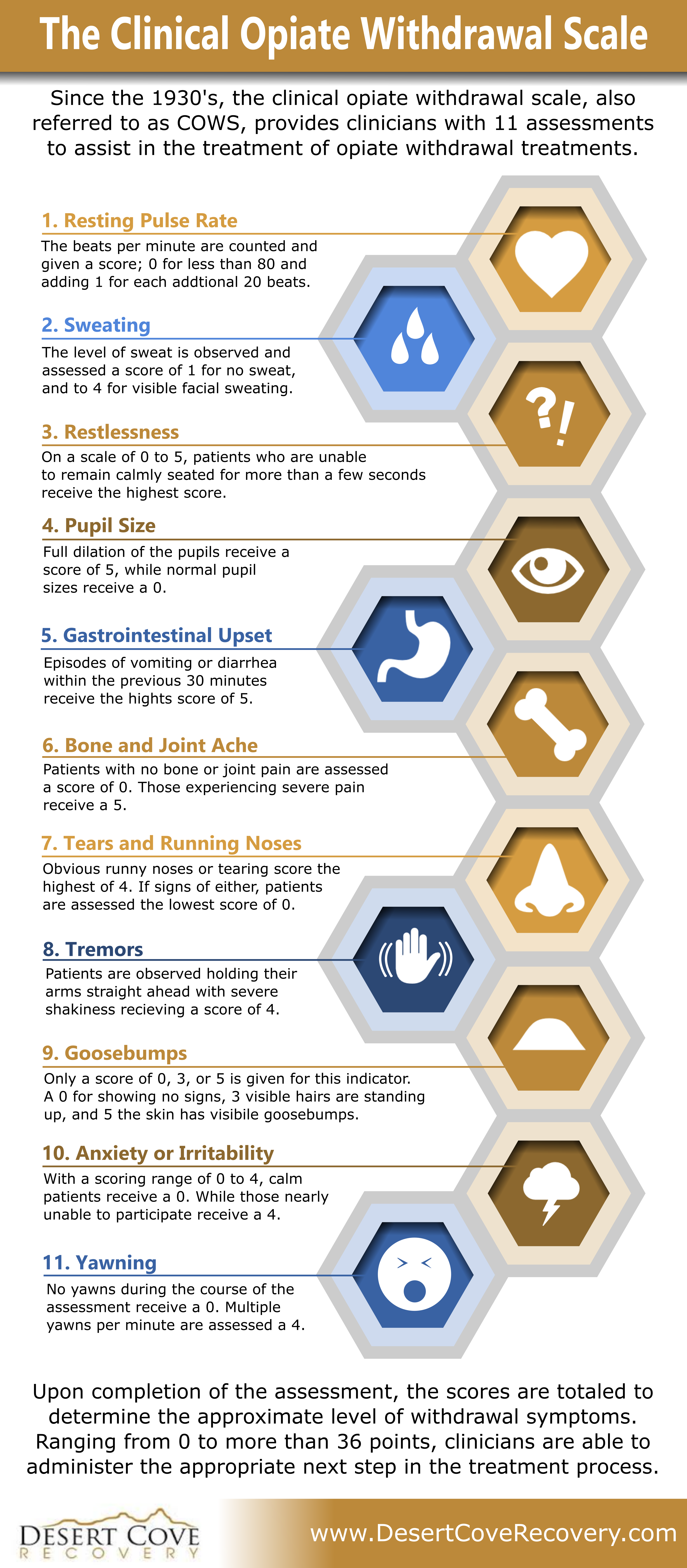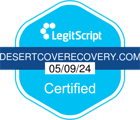What is the Clinical Opiate Withdrawal Scale?
Everyone’s experience with addiction is different. Likewise, everyone’s path toward recovery is unique. When it comes to overcoming an addiction to opiates, seeking outside help is a must. For that help to be effective, a treatment plan that is tailored to suit the needs of the individual patient is essential. Rehab facilities have many tools at their disposal, and one of the best ones for assessing a patient’s withdrawal symptoms is something called the Clinical Opioid Withdrawal Scale, or COWS scale for short. Read on to learn more about this useful opiate withdrawal scale and how it is used to help people overcome serious addictions.
How Does the Clinical Opioid Withdrawal Scale Work?
Often abbreviated simply as COWS, the Clinical Opioid Withdrawal Scale is an 11-item assessment tool that is used to rate common symptoms and signs of opiate withdrawal. Unlike the Subjective Opiate Withdrawal Scale, or SOWS, which is a self-reporting tool, it is designed to be administered by a clinician. Each of the 11 listed symptoms are given a score on a scale of 0 to 5, with 5 representing the most severe manifestation of the symptom in question. The patient’s cows score is then tallied and used to determine a tailored opioid withdrawal treatment plan.
Continued after image:

11 Symptoms Assessed by the Clinical Opioid Withdrawal Scale
Inpatient and outpatient treatment centers alike rely on tools like the COWS scale to help patients safely withdraw from opiates. In particular, medications like buprenorphine and suboxone are often prescribed to help manage the most severe and uncomfortable symptoms. In turn, patients are less likely to relapse due to severe discomfort. However, to be effective, these medications must be administered at strategic points in the withdrawal process. The COWS scale is the primary tool that clinicians use to determine not only which medications should be used but when they should be administered.
Detailed Breakdown of the 11 Symptoms on the COWS Scale
1. Resting pulse rate – The patient’s pulse is monitored regularly. A resting pulse of 80 or below is given a score of zero while a resting pulse of 120 or higher is given a score of five.
2. Gastrointestinal upset – Symptoms may range from none to multiple episodes of vomiting and diarrhea.
3. Sweating – This symptom may not be present at all. On the other end, sweat may be streaming from the face or body.
4. Tremors – Tremors may not be present, or they may be severe enough to interfere with a patient’s ability to speak or move.
5. Restlessness – On the COWS scale, this symptom may not be present at all. In the worst case, the patient may be unable to sit still for more than a few seconds at a time.
6. Yawning – No yawning may be happening at all, or it may be happening as frequently as several times per minute.
7. Pupil size – Pupils may be pin-sized when exposed to light, or they may be extremely dilated on the more severe end of the scale.
8. Irritability and anxiety – Someone experiencing opioid withdrawals scale may show no sign of anxiety or irritability at all, or they may be so anxious or irritable that they struggle to participate in the assessment.
9. Bone and joint aches – This symptom can range from very mild to so severe that the patient is constantly rubbing their joints and unable to sit still.
10. Gooseflesh skin – Skin may be smooth on one end of the scale or look like gooseflesh on the other.
11. Teary eyes and runny nose – These symptoms may be missing entirely, or the eyes and nose may run constantly on the more severe end of the scale.
Understanding Your COWS Score: Interpretation and Severity Levels
After assessing the patient for each of the 11 symptoms, their score is tallied to determine how severe their withdrawal is. A score of 5 to 12 represents mild withdrawal while a score of 36 or higher represents severe withdrawal. Clinicians may use other scales in conjunction with COWS to gain an even clearer understanding of a patient’s current state; the Buprenorphine Administration Scale, for example, is often used in conjunction with COWS to determine effective doses of that medication as well as when to administer it. With many medications, introducing them too early can have the opposite effect, which can lead to a longer and more difficult withdrawal period.
The Role of the COWS Scale in Managing Opiate Withdrawal Treatment
Using the COWS scale opiate withdrawal tool is standard practice in many addiction treatment facilities. The scale not only identifies the intensity of symptoms but also plays a crucial role in determining when it is safe to initiate medications like Suboxone or methadone. Introducing these drugs too early—before the COWS score opioid reaches a certain threshold—can worsen withdrawal symptoms, making the process longer and more uncomfortable. For this reason, clinicians often use both the clinical opioid withdrawal scale and other assessment tools to optimize care.
Medication-Assisted Treatment and the COWS Scale: When Is the Right Time?
Timing is critical in administering medications for opioid withdrawal. The clinical opioid withdrawal scale helps determine the precise moment when introducing medications like buprenorphine is both safe and effective. Starting too soon can trigger precipitated withdrawal, a condition that causes symptoms to worsen rapidly.
This is why MAT protocols often require a minimum COWS score opioid before medication can begin. Using the COW scale withdrawal method allows clinicians to track patient readiness and minimize risk.
What to Expect During Opioid Withdrawal: Timeline & Symptoms
Opioid withdrawal symptoms typically begin within 6–12 hours of the last dose (for short-acting opioids) and can last up to a week or more. During this time, clinicians use the COWS scale scoring to monitor progress, manage pain, and adjust treatment plans. Common symptoms include muscle aches, anxiety, nausea, sweating, and agitation—all captured in the clinical opioid withdrawal scale for accurate tracking.
While withdrawal can be intense, proper assessment using tools like the opiate withdrawal scale ensures safer and more comfortable detox experiences. Once withdrawal stabilizes, patients can begin long-term recovery treatments and counseling.
Ready to Start Opiate Addiction Treatment? Here’s What You Need to Know
If you are coping with an addiction to opiates and are ready to regain your freedom from substance abuse, it’s important to understand that help is absolutely vital—and it is readily available. Detoxing from the drug is the first step, and the right inpatient or outpatient treatment program will use the COWS scale or other proven tools to determine the best-individualized plan for you. Once detoxing is over, you will be free to begin the real work of addiction recovery and to take the first steps toward a lifetime of sober living.



